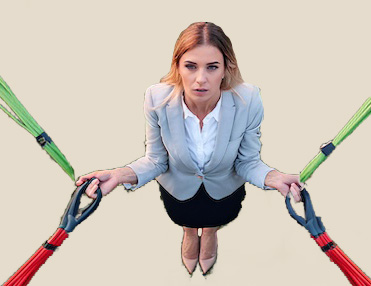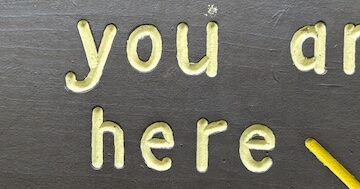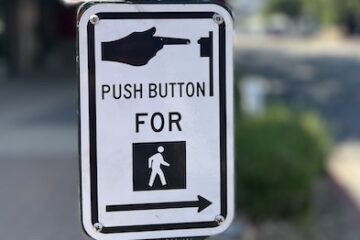Stuck in a web of bungee cords: ambivalence in decision making
In decision making, ambivalence is like being stuck at the middle of a web of bungee cords.
Each time you pull on one of the cords, you can only get so far before the others yank you back into being stuck in the inertia of ambivalence.
Your internal dialog goes something like this:
If I decide A, then that means B and C will change. But if I decide B, then A and C will change. But if I decide C…
One of my earliest clients faced this problem. She wanted to change careers. She wanted to move across the country. She wanted to honor family relationships. And she was in the middle of a budding romance.

Every time she thought about making a decision on one of them, she got pulled back into the ambivalence abyss by that web of bungee cords, and she lost herself in the swirl of complexity that resulted.
She couldn’t decide one without impacting the others.
Complexity makes decision making hard
Every big life decision is complex because it affects many other parts of your life. Whether it’s a career change, a marriage or divorce, having a baby, becoming someone’s caregiver, moving to a new city, getting an advanced degree… the ripples will affect many aspects of your life.
We all have only so much time, energy, and money to invest in whatever we’re choosing, so the pressure to get it “right” can feel intense. And that pressure magnifies as you get older because you feel you have less margin for error.
It’s easy to get so wrapped up in the complex web of details that you lose sight of the things that are truly important in the decision making process. It’s so easy to get lost in the immediate impacts that you lose sight of the bigger picture possibilities.
I sometimes remind my clients that their most important goal may be to minimize the regret their future self will feel.
Yet that web of bungee cords is hard to break free of.
Pick an anchor point and detach the rest
With the client I mentioned above, it became clear she needed to figure out which of the decisions was the most important and let everything else flow from that. She needed to pick one as her anchor point.
She decided that moving to a new city was her top-top priority among four seemingly equal top priorities.
Immediately when she decided that, it was like she had unhitched the other three bungee cords. This took a lot of trust and faith in herself; it wasn’t easy to allow herself to limit her options on the other important choices.
Moving to a new city would limit her job choices. Moving would put distance between herself and her family. It would also put her closer to that romantic interest she was getting involved with.
And it would put her at risk of being judged by everyone else in her life.
How to pick an anchor point in decision making
Getting to the point where she knew which of those four top priorities was her top-top priority was not easy. We talked through it over several coaching sessions and explored lots of different camera angles on all her options.
Ultimately, these were the most important decision tools that worked for her and which I’ve relied on to positive effect with other clients over the years.
1. Know your core values
Getting very specific about your core values is the first step to a lot of big life decisions. The most important part of that process, in my opinion, is having to draw some very bright lines between what is important to you, and what others say should be important to you.
Going through that exercise with cold, brutal honesty helped my client see clearly where her decision process was being polluted by other people’s value systems that were different from hers. Friends and family both were advising her in what they thought was her best interest, but none of them was living her life.
To reduce regret and resentment in the future, you have to fully own your decisions. If you feel someone else is pushing you into something that’s not right for you, then it’s probably not going to go so great in the long run.
Owning your decisions means opening yourself up to judgment from others, but would you rather come to peace with being judged, or would you rather live the wrong life?
2. Avoid catastrophizing
For my client, moving might mean losing her current job. The company was returning to the office after COVID, and they did not have an office in the city she wanted to live. With no significant financial cushion, the idea of being jobless killed her ability to think creatively.
Together, we discovered several options she hadn’t thought of on her own. By being honest with her boss and asking for help in figuring out how to make it all work out, she learned of an opening in another department that would allow her to work remotely. She applied for and got that job, and it was what she needed to take the pressure off that move.
Things don’t always work out this well, of course, but as long as she was stuck in a fear mindset, she wasn’t even able to imagine this path.
When you have a fear around one of your decision points, that fear can stop you from being both objective about your situation and creative in your problem solving. If you allow that fear to have power over your imagination, you may end up giving it too much weight in your overall decision making process.
3. Have a chat with your future self
Your future self will have to deal with the consequences of whatever you end up deciding. So, in addition to any other trusted confidantes, coaches, and counselors you rely on, visualize having a chat with your future self.
I recommend setting aside some time to do this, just like it takes time to really explore your core values with honesty and clarity. Most people are not practiced in visualizing talking to their future self. I rarely do it, so why should I expect you to?
Whatever it is you need to do to get in a mode where you can honestly and objectively imagine how your future self will feel about each of your options, do it. If one of the highest goals is to minimize future regret, you need to really understand what your future self might regret the most.
It’s easy to scoff this one off and say “well, if it all works out, then my future self will not have any regrets!” This may be true, but that won’t help you make decisions today, and making decisions today is the reason you’re reading this blog post.
Perhaps your future self will be angry that you chose A, which made B and C a lot more work and created problems D, E, and F. Or perhaps they’ll watch you choose B and then deal with decades of resentment that B was really what someone else wanted you to do, and you weren’t strong enough to tell them “no.”
I don’t know how this conversation with your future self will work out, and it isn’t for everyone, but I have used it and have seen others use it to lead to powerful insights. Often, when forced to get close to their imagined future self, they see how choices they’ve made to date have been leading them in the wrong direction. Now is the time to make corrections.
If you don’t have an anchor point, one will be provided for you
All of these things are helpful if you want to live with intentionality. It takes courage and faith in yourself to let go of one important thing in a way that lets you move forward on another.
If you don’t go through decision making with intentionality, then you will live a life designed by committee, where other people (or luck, or fate) decide your anchor points for you. You may often feel pulled in the wrong direction, or stuck in a place you don’t like… and you won’t be able to figure out why.
The scary part of intentionality is that your future self will have no one to blame for a bad decision but you. So, if your highest goal is to be able to blame others for how your life turns out, then by all means avoid doing these things.
And if that’s really how you want to live your life, then why are you reading my blog?
Sign up for a free coaching consultation
Looking to be a better leader? Contemplating a career change? Struggling with a big life question? Want to write or publish a book? Thinking about retirement? I can help. Schedule a free coaching session now.
Get my core values exercise free
This simple worksheet helps identify your core values. Many of my clients find it surprisingly eye-opening, and it’s helped people make some big life decisions. Get it here.



1 Comment
Exiting the Decision Circle - Gray Bear Coaching LLC · October 6, 2025 at 2:26 pm
[…] is a little different then being in the middle of a web of bungee cords. That’s when any decision you make has so many repercussions on the other choices that they pull […]